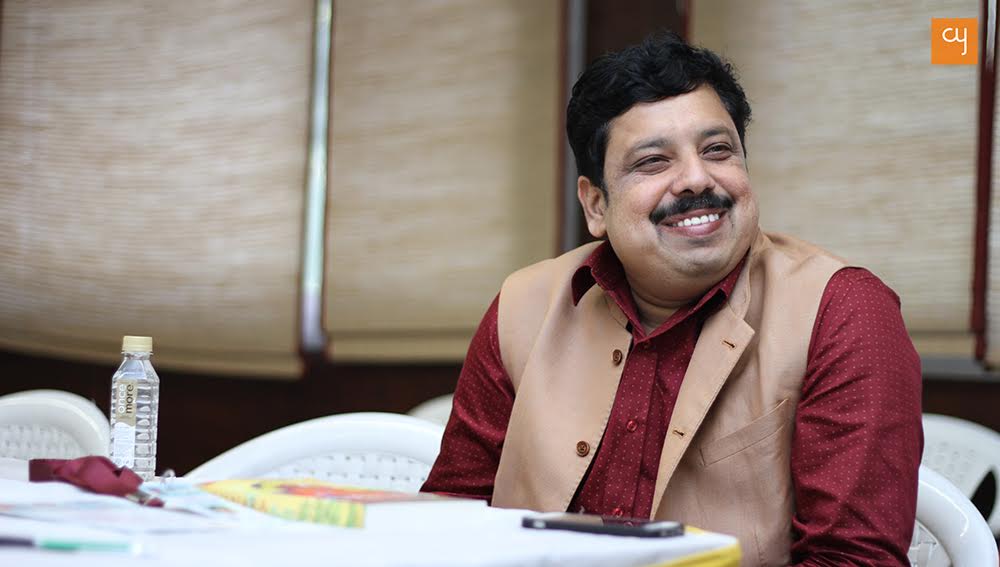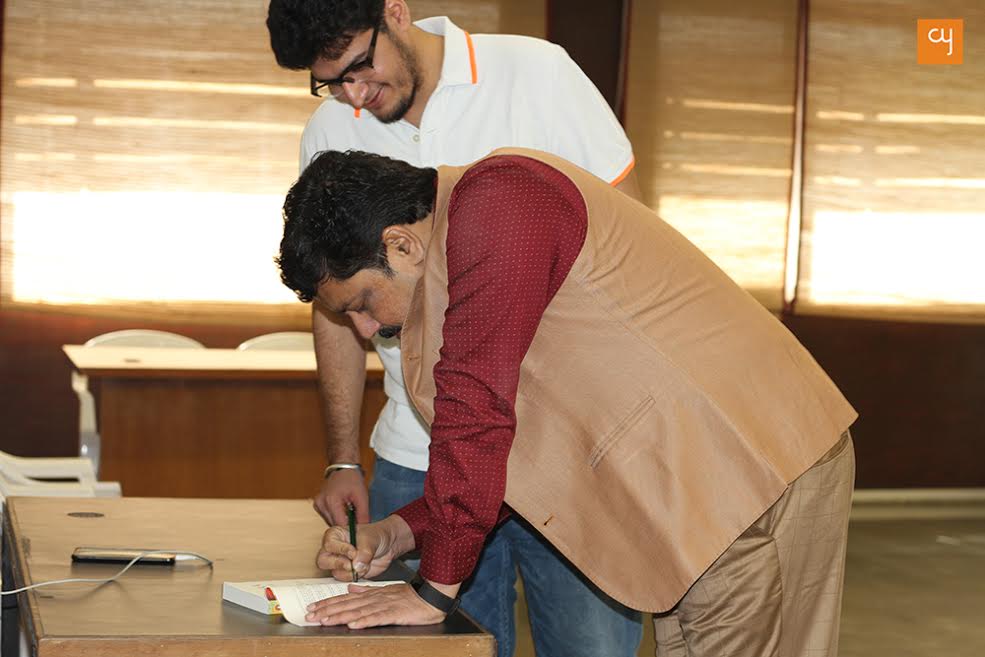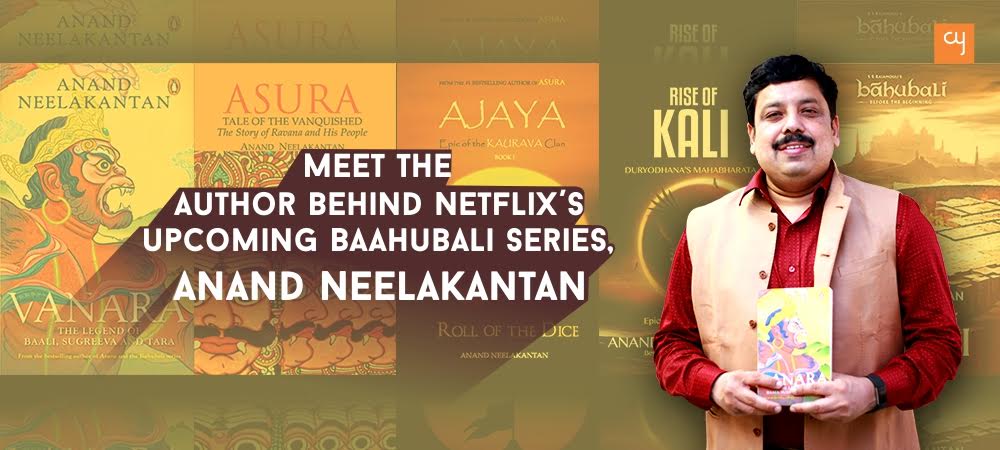Meet the author behind Netflix’s upcoming Baahubali series, Anand Neelakantan
What prompted Netflix to adapt ‘The Rise of Sivagami’ into a web series? Why does writer Anand Neelakantan often choose to write from the perspective of the ‘evil’ party, like the Kauravas and Ravana? When were the seeds of mythology sown in the author of such bestselling novels like ‘Asura: Tale of the Vanquished’? Find out in this exclusive interview.
When Netflix declared that it would adapt Neelakantan’s novel The Rise of Sivagami into a Baahubali web-series, the internet went wild on hearing the news. The 9-episodes-long first season of Baahubali: Before the Beginning will explore the story of Queen Sivagami and the rise of the empire Mahismati, as described in the novel. As an aspiring writer, I felt overjoyed by the chance to interview the one man who has transformed my understanding of Indian mythology forever. Anand Neelakantan approaches mythology in a way very few ever have. He often looks at Indian epics like the Mahabharata and Ramayana from the perspective of the defeated party. His bestselling novels Ajaya: Roll of the Dice and Ajaya: Rise of Kali speak through the perspective of the Kauravas, the nemeses of the Pandava brothers in the Mahabharata; while his bestselling book Asura: Tale of the Vanquished depicts the Ramayana through the perspective of the ‘evil’ king Ravana.
“If Lord Duryodhana was an evil man, why did great men like Bhishma, Drona, Kripa, Karna, entire army of Krishna fight war on his side??”
― Anand Neelakantan, Ajaya: Roll of the Dice
The multidisciplinary creator, who writes for TV shows like Siya Ke Ram and Sankat Mochan Mahabali Hanuman, is also a motivational speaker who draws mindful cartoons for periodicals. The author has been honoured with multiple accolades like the Crossword Popular Awards and Kalinga International Literary Award. But when not writing, he works with the Indian Oil Corporation, with whom he has worked since almost two decades.
I met with the author on the inaugural day of the Ahmedabad International Literature Festival in November, for which he had been invited as a keynote speaker. Soon into our discussion, I was left awestruck. The highly conversant Neelakantan was soft-spoken and beamed brightly. We talked about his novel The Rise of Sivagami and he spoke of how he thinks his latest creation Vanara: The Legend of Baali, Sugreeva and Tara is his best work. He reminisced about his early “Malgudi Days” in his hometown of Thrippunithurain Kerala and explained how writing for Indian TV serials can demand more black-and-white characterisations. Here we are, in conversation with Anand Neelakantan:
In your work, you re-tell traditional stories in a very different way. How do you shape the perspective with which to tell a story?
I like changing the perspectives. I believe that history has always been written by the people who won, so the vanquished ones have a different tale to tell. The moment you start watching the story of Mahabharata or Ramayana from the perspective of Duryodhana or Ravana, the entire viewpoint changes. When I write, I throw light from a different angle, and thus the shadow falls on a different side of the character.
What attracted the online streaming giant Netflix to adapt your novel The Rise of Sivagami into a web series?
The name of Baahubali caught their eye, there is no denying that but what attracted them the most is the novel’s grey areas and characters. Grey elements are good for a web series. Like in Sacred Games, there is no good or bad. Films, on the other hand, are black and white and they have a defined good or bad character or situation. In The Rise of Sivagami, everybody is good and bad at the same time, like all of us in our everyday lives. On some days, we are right. Sometimes, we are wrong. Again, keeping the story human without exaggeration is a mix that worked too.
How does your writing differ when you write for screenplays versus books?
Siya Ke Ram, Chakravartin Ashoka Samrat, Sankat Mochan Mahabali Hanuman and Adaalat–2 are some of the Indian television series I’ve written for till now. And the difference in writing, as I told you previously, is all about perspectives. The moment I start screenwriting for Indian TV, I write from the standpoint of Hanuman who automatically becomes the hero and Bali becomes the villain (laughs heartily). It is not propaganda. I don’t want to prove anything. I work like an artist who views elements from various angles and then draws them up to be made of different sides.
In a country where language can change every few kilometres, even stories can change vastly over time. With so many variations in the plot of anyone epic, how do you maintain factuality?
There are countless variations of a single epic. If we pick the Ramayana, there are variations of it where Sita kills Ravana. In Jain Ramayana, it is said that Sita is the daughter of Ravana. In another variant, it has been described that Hanuman is not a Brahmachari, but has multiple wives. The Buddhist Ramayana says Ram, Laxman and Sita were siblings. So the moment you start researching, you realise that there are different styles of narration. To make my stories historical accounts, I take out all the magical fantasy elements and make my story and elements more human. I peel off all the exaggerated things and try to preach the story as a historical tale with no gods or evil. A lot of propaganda and exaggerations could be added to create drama, but I decide to put up elements of historical truth, rather than gods or demons.

When were the seeds of mythology sown in you?
I come from a very traditional town and family, and my childhood was spent in the capital of the ancient kingdom of Cochin, in Thrippunithura, Kerala. I was surrounded by more than 108 temples devoted to various gods and goddesses, and all of these 800- to 1000-year-old temples were located in a small town of around 20 sq km. My Malgudi-Days-style childhood was spent on temple grounds, revolving around elephants, absorbing songs, Carnatic music, and temple art forms like Kathakali, Bharatnatyam and Koodiyattam, which were based on the stories of Mahabharata, Ramayana and various other Puranas. Although, with time, the merchant place has taken over the culture space and the area has been swallowed by Cochin city, even today, if you visit the city in the month of November-December, you will find numerous festivals and traditional arts being performed in an authentic setting.
Did you leave your profession as an engineer to write?
I am still very much associated with the Indian Oil Corporation and haven’t left my job. I am on leave. The organisation is cooperative and gives me as many leaves as I want (chuckles).
Tell us about your latest book, Vanara: The Legend of Baali, Sugreeva and Tara.
I can say that Vanara is the best book out of all my five creations. It’s a focused and engaging read, comprising of only 300 pages (with a cyclone of love, lust and betrayal), published by Penguin India. The story of Bali, Sugreeva and Tara is arguably the world’s first love triangle that we remember. Tara was the wife of Bali. Tara was the wife of Sugreeva. And it was so much like a Bollywood story, that, incidentally, the rights are soon going to get picked for a movie to be made on it.

Only a few days after the interview and two days after its official release, it was announced that Anand Neelakantan’s ‘Vanara’ would be adapted into a feature film by Dar Motion Pictures, in association with KR Movies. The production line has previously given critically acclaimed movies like Ugly, The Lunchbox and D-Day.
Yatra Archives

 How Tulika Books is creating impact in children’s lives through picture books
Nandini Varma
How Tulika Books is creating impact in children’s lives through picture books
Nandini VarmaAug 21, 2019
A children’s book about a boy who feels like a girl. And about a child brought up by grandfathers. These are some of the stories published by Tulika Books, who have been making children’s picture books since 23 years. Little…
 Dalgona Coffee: A worldwide social media trend about home-made café experience
Harshil Shah
Dalgona Coffee: A worldwide social media trend about home-made café experience
Harshil ShahApr 2, 2020
While the lockdown has ignited various trends on social media, one that has received a major global following is #DalgonaCoffee. With thousands of posts on its name, here’s all you need to know about the Dalgona Coffee wave. I first…
 Leonardo, Michelangelo, Raphael and Donatello—Artists or Teenage Mutant Ninja Turtles characters?
Harshil Shah
Leonardo, Michelangelo, Raphael and Donatello—Artists or Teenage Mutant Ninja Turtles characters?
Harshil ShahNov 5, 2019
Did you ever wonder where the Teenage Mutant Ninja Turtles’ characters got their names from? Well, your search is complete. Here is a brief introduction of the artists from whom the creators of TMNT took inspiration. Teenage mutant ninja turtles,…
 The call of the mountains: orthopaedic Dr Yatin Desai’s advice on trekking
Himanshu Nainani
The call of the mountains: orthopaedic Dr Yatin Desai’s advice on trekking
Himanshu NainaniMay 24, 2019
In this piece 64 year old Dr Yatin Desai, shares with CY his inspiring story of how to scale towering mountains with utmost ease and how this life adventure activity can shape human character and health. Chances are high that…




